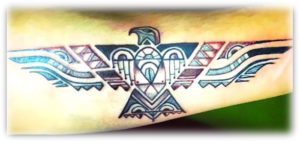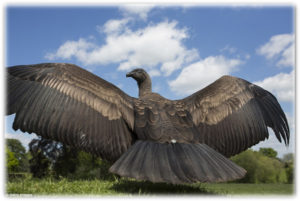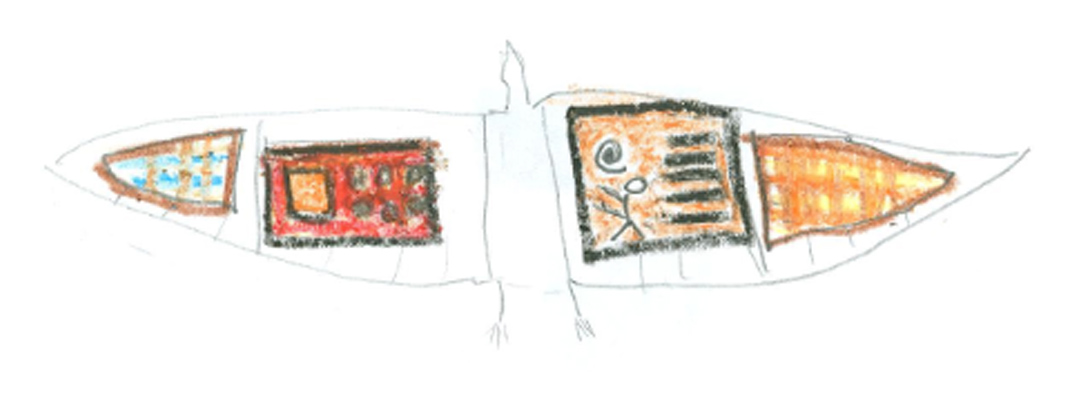I drew this picture which was what I saw in my dream on December 27/28, 2009. In my dream I was flying and below me was this large and beautiful bird. It appeared to have painting on its wings. There was very colorful and painted patterns. The colors ranged from orange, red, green, brown and the patterns appeared as transparent from my view.
The bird was brown and very large. So large it appeared to have the wing span of a small 2 person airplane. I was above this bird looking down on it as it flew. The land below appeared as very open. There were mountains yet there were no trees. I found myself flying lower to meet land on the large bird and fly with it. It was an incredible and beautiful experience. I woke soon after and felt bliss, happiness, new.
The Moon was in Taurus when I had this dream. It was conjunct Mars in Taurus in my chart in my fourth house. Mars the God of movement, war, activity, desire.

I was so in awe of what I had seen following this dream and decided to research what kind of bird this could be. In examining the Thunder Bird and the Condor, I decided this was a Thunderbird. The pictures of the natives view of the Thunderbird were quite accurate to what I saw and later I learned during a fire ceremony as I graduated from a year long Shamanic Practices education that I am a Heyoka. I was born backwards and it is my natural way to do things backward. When it came my time to dance around the fire in celebration of my acceptance of the responsibilities that come with doing shamanic healing and practices, I naturally began my dance in a counter clockwise direction. I was told by the grandmother who oversaw the ceremony that I was a Heyoka. This was my way.
In Native traditions the appearance of a Thunderbird meant an omen of war when the sound of thunder was heard. The name of the Thunderbird name originates from the belief that the beating of its enormous wings causes thunder and stirs the wind. The Native Americans believed that the giant Thunderbird could shoot lightning from its eyes. Thunder was believed to be a sign the spirits were at war in the skies but this also foretold of victory for tribal wars fought on the ground. The Thunderbird Symbol of the Mississipian Mound Builders was displayed as masks as they were believed to hold spiritual powers that never left them. They also believed that the masks would identify them with the spirits and activate their power.
The thunderbird was a spirit of the Underworld and associated with their Bird Man symbols and beliefs. The bird man was portrayed in the guise of an eagle, hawk or falcon. These birds were all strong, high flying predators together with raptor like creatures. The horns that are often displayed in Thunderbird symbols signified spiritual power, especially when applied to animals that did not ordinarily have them such as Birds, Panthers, Avanyu and Snakes (Serpents). It is believed among the Lakota Sioux that if you had a dream or vision of birds you were destined to be a Medicine Man. If you had a vision of the Thunderbird, it was your destiny to become a sacred clown. The sacred clown is the heyoka (heyókȟa, also spelled “haokah,” “heyokha”) is a kind of sacred clown in the culture of the Lakota people of the Great Plains of North America. The heyoka is a contrarian, jester, and satirist, who speaks, moves and reacts in an opposite fashion to the people around them. Only those having visions of the thunder beings of the west, the Wakíŋyaŋ, and who are recognized as such by the community, can take on the ceremonial role of the heyoka. The Lakota medicine man, Black Elk, described himself as a heyoka, saying he
had been visited as a child by the thunder beings. (Thunderbirds).
The Heyókȟa is thought of as being backwards-forwards, upside-down, or contrary in nature. This manifests by their doing things backwards or unconventionally—riding a horse backwards, wearing clothes inside-out, or speaking in a backwards language. For example, if food is scarce, heyókȟa may sit around and complain about how full he is; during a baking hot heat wave, a heyókȟa might shiver with cold and put on gloves and cover himself with a thick blanket. Similarly, when it is freezing he might wander around naked, complaining that it is too hot. A unique example is the famous heyókȟa sacred clown called “the Straighten-Outer”: He was always running around with a hammer trying to flatten round and curvy things (soup bowls, eggs, wagon wheels, etc.), thus making them straight. — John Fire Lame Deer. The heyókȟa symbolizes and portrays many aspects of the sacred beings, the Wakíŋyaŋ. His satire presents important questions by fooling around. They ask difficult questions, and say things others are too afraid to say. Their behavior poses questions as do Zen koans. By reading between the lines, the audience is able to think about things not usually thought about, or to look at things in a different way.

Principally, the heyókȟa functions both as a mirror and a teacher, using extreme behaviors to mirror others, and forcing them to examine their own doubts, fears, hatreds, and weaknesses. Heyókȟa have the power to heal emotional pain; such power comes from the experience of shame—they sing of shameful events in their lives, beg for food, and live as clowns. They provoke laughter in distressing situations of despair, and provoke fear and chaos when people feel complacent and overly secure, to keep them from taking themselves too seriously or believing they are more powerful than they are. In addition, sacred clowns serve an important role in shaping tribal codes. Unbound by societal constraints, heyókȟa are able to violate cultural taboos freely and thus critique established customs. Paradoxically, however, by violating these norms and taboos, they help to define the accepted boundaries, rules, and societal guidelines for ethical and moral behavior. They are the only ones who can ask “Why?” about sensitive topics; they use satire to question the specialists and carriers of sacred knowledge or those in positions of power and authority. For people who are as poor as us, who have lost everything, who had to endure so much death and sadness, laughter is a precious gift. When we were dying like flies from white man’s disease, when we were driven into reservations, when the government rations did not arrive and we were starving, watching the pranks and capers of Heyókȟa were a blessing.
— John Fire Lame Deer
In Native American cultures and traditions Condors are considered sacred animals particularly California Indian tribes and the Andean tribes of South America. According to the origin mythology of the Wiyot Indians, Condor was the ancestor of their tribes. Other California tribes believe condors have healing powers, and California Indian doctors frequently use condor feathers as part of their traditional medicine ceremonies. In the Quechua and Aymara cultures of South America, Condor is a symbol of the sky, and is frequently represented in tribal art. The Mapuche people call Condor the King of Birds, and believe he embodies the four cardinal virtues of wisdom, justice, goodness, and leadership. Some California tribes, like the Chumash, Miwok and Pomo, have also had a Condor Dance among their tribal dance traditions.
So you see, my dream was of what was to come in my life. A month later I began studying Shamanic Practices and have never stopped. It brings beauty to my life and I am able to bring back healing knowledge to anyone who is open to receive it.
I might add that 3 years before this dream I had a dream where I was walking by a riverbed and beside me was a native american elder lady. She had long beautiful grey, white hair which was in braids and she had on moccasins of light dear skin and a dress of the same material with lots of colorful beads sewn into her dress. She was gentle and warm and as we walked she pointed down to the ground and I noticed a large pile of beautiful grey and white feathers. She said to me, “these will be yours in a couple of years”. When I woke up I again was in awe of what I had seen. I consulted with a mentor of mine at the time and she said she thought these were Falcon feathers. The meaning behind the pile of feathers was as follows. Moving forward in my life I would experience abundance, action, adaptability, awareness, balance, change, communication, community, confidence, connection, courage, creativity, curiosity, defense, determination, devotion, dreams, emotions, endurance, energy, family, fertility, gentleness, grace, independence, intelligence, intuition, joy, love, loyalty, magic, movement, patience, peace, playfulness, power, protection, rebirth, resourcefulness, sensitivity, strength, survival, transformation, trust, and wisdom.
